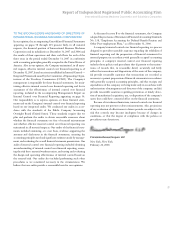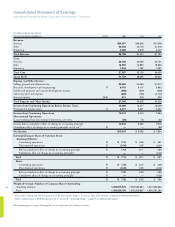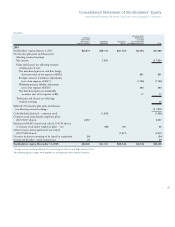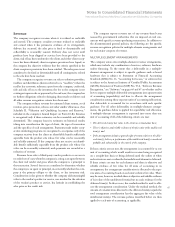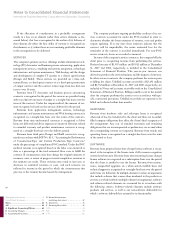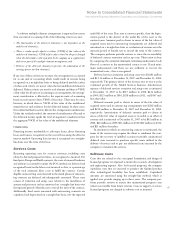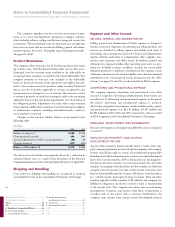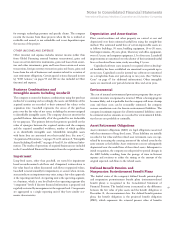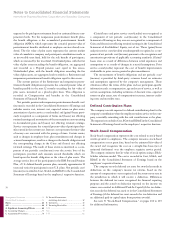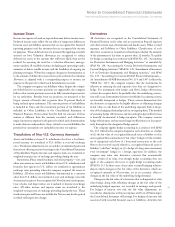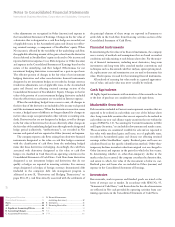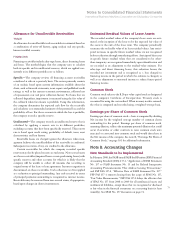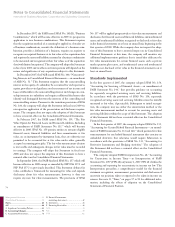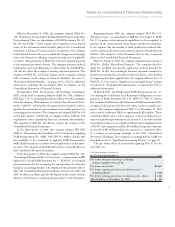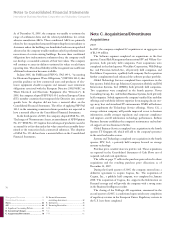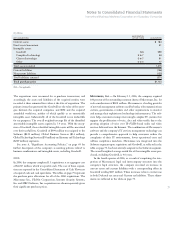IBM 2007 Annual Report Download - page 69
Download and view the complete annual report
Please find page 69 of the 2007 IBM annual report below. You can navigate through the pages in the report by either clicking on the pages listed below, or by using the keyword search tool below to find specific information within the annual report.67
Notes to Consolidated Financial Statements
International Business Machines Corporation and Subsidiary Companies
A software multiple-element arrangement is separated into more
than one unit of accounting if all of the following criteria are met:
U The functionality of the delivered element(s) is not dependent on the
undelivered element(s);
U There is vendor-specific objective evidence (VSOE) of fair value of the
undelivered element(s). VSOE of fair value is based on the price charged
when the deliverable is sold separately by the company on a regular basis
and not as part of the multiple-element arrangement; and
U Delivery of the delivered element(s) represents the culmination of the
earnings process for that element(s).
If any one of these criteria are not met, the arrangement is accounted
for as one unit of accounting which would result in revenue being
recognized on a straight-line basis or being deferred until the earlier
of when such criteria are met or when the last undelivered element is
delivered. If these criteria are met for each element and there is VSOE
of fair value for all units of accounting in an arrangement, the arrange-
ment consideration is allocated to the separate units of accounting
based on each unit’s relative VSOE of fair value. There may be cases,
however, in which there is VSOE of fair value of the undelivered
item(s) but no such evidence for the delivered item(s). In these cases,
the residual method is used to allocate the arrangement consideration.
Under the residual method, the amount of consideration allocated to
the delivered item(s) equals the total arrangement consideration less
the aggregate VSOE of fair value of the undelivered elements.
FINANCING
Financing income attributable to sales-type leases, direct financing
leases and loans is recognized on the accrual basis using the effective
interest method. Operating lease income is recognized on a straight-
line basis over the term of the lease.
Services Costs
Recurring operating costs for services contracts, including costs
related to bid and proposal activities, are recognized as incurred. For
fixed price Design and Build contracts, the costs of external hardware
and software accounted for under the POC method are deferred and
recognized based on the labor costs incurred to date, as a percentage
of the total estimated labor costs to fulfill the contract. Certain
eligible, nonrecurring costs incurred in the initial phases of outsourc-
ing contracts are deferred and subsequently amortized. These costs
consist of transition and setup costs related to the installation of
systems and processes and are amortized on a straight-line basis over
the expected period of benefit, not to exceed the term of the contract.
Additionally, fixed assets associated with outsourcing contracts are
capitalized and depreciated on a straight-line basis over the expected
useful life of the asset. If an asset is contract specific, then the depre-
ciation period is the shorter of the useful life of the asset or the
contract term. Amounts paid to clients in excess of the fair value of
acquired assets used in outsourcing arrangements are deferred and
amortized on a straight-line basis as a reduction of revenue over the
expected period of benefit not to exceed the term of the contract.
The company performs periodic reviews to assess the recoverability
of deferred contract transition and set up costs. This review is done
by comparing the estimated minimum remaining undiscounted cash
flows of a contract to the unamortized contract costs. If such mini-
mum undiscounted cash flows are not sufficient to recover the
unamortized costs, a loss is recognized.
Deferred services transition and setup costs were $1,881 million
and $1,511 million at December 31, 2007 and December 31, 2006,
respectively. The primary driver of the increase year to year was the
continued growth of the Global Services business. Amortization
expense of deferred services transition and setup costs is estimated
at December 31, 2007 to be $517 million in 2008, $414 million
in 2009, $325 million in 2010, $258 million in 2011, and $367 mil-
lion thereafter.
Deferred amounts paid to clients in excess of the fair value of
acquired assets used in outsourcing arrangements were $202 million
and $210 million at December 31, 2007 and December 31, 2006,
respectively. Amortization of deferred amounts paid to clients in
excess of the fair value of acquired assets is recorded as an offset of
revenue and is estimated at December 31, 2007 to be $92 million in
2008, $46 million in 2009, $33 million in 2010, $20 million in 2011,
and $11 million thereafter.
In situations in which an outsourcing contract is terminated, the
terms of the contract may require the client to reimburse the com-
pany for the recovery of unbilled accounts receivable, unamortized
deferred costs incurred to purchase specific assets utilized in the
delivery of services and to pay any additional costs incurred by the
company to transition the services.
Software Costs
Costs that are related to the conceptual formulation and design of
licensed programs are expensed as incurred to research, development
and engineering expense. Also, for licensed programs, the company
capitalizes costs that are incurred to produce the finished product
after technological feasibility has been established. Capitalized
amounts are amortized using the straight-line method, which is
applied over periods ranging up to three years. The company per-
forms periodic reviews to ensure that unamortized program costs
remain recoverable from future revenue. Costs to support or service
licensed programs are charged to software cost as incurred.


